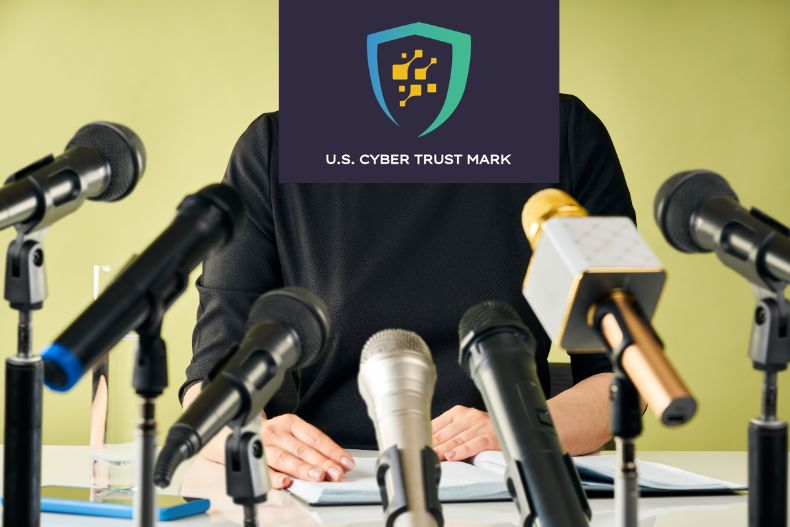The U.S. government has introduced a new initiative aimed at enhancing consumer protection: the US Cyber Trust Mark. This program is designed to help consumers easily identify internet-connected devices that meet stringent security standards. But what exactly does this mean for consumers and businesses? Let’s break it down.

What Is the US Cyber Trust Mark?
The US Cyber Trust Mark is a labeling program initiated by the Federal Communications Commission (FCC). It applies to smart devices such as routers, security cameras, baby monitors, and other Internet of Things (IoT) products. This voluntary certification ensures that a product has met baseline cybersecurity requirements, making it safer from hacking and other cyber threats.
Why Is It Important?
With an increasing number of smart devices in homes and businesses, cybercriminals have more opportunities to exploit security vulnerabilities. Many consumers unknowingly use devices with weak security protections, making them easy targets for hackers. The Cyber Trust Mark helps:
- Consumers make informed choices about secure products.
- Manufacturers gain credibility by demonstrating strong security measures.
- Businesses ensure their IoT products are more resilient to cyber threats.
How Does It Work?
Manufacturers who wish to receive the Cyber Trust Mark must comply with security standards set by the National Institute of Standards and Technology (NIST). These standards include:
- Strong default passwords
- Regular software updates
- Secure data encryption
- Protection against common cyber vulnerabilities
Once a product meets these requirements, it will feature a Cyber Trust Mark label (similar to an Energy Star label for appliances). This mark signifies that the device has passed cybersecurity evaluations.
How Will This Impact Consumers?
For consumers, the Cyber Trust Mark offers reassurance that the devices they purchase meet government-approved security standards. This means fewer risks of data breaches, identity theft, or personal information leaks.
Consumers can look for the Cyber Trust Mark on product packaging and scan a QR code to access detailed security information about the device. This transparency will help individuals make more informed purchasing decisions.
What It Means for Businesses and Manufacturers
For businesses that manufacture or sell smart devices, participating in the Cyber Trust Mark program can enhance brand reputation and customer trust. Companies that prioritize cybersecurity will likely gain a competitive edge in the market.
Additionally, compliance with cybersecurity standards could become a requirement for government contracts and partnerships, making this initiative important for long-term business sustainability.
Are Companies Required to Participate in the Cyber Trust Mark Program?
Participation in the Cyber Trust Mark program is voluntary. However, companies that choose to certify their devices can benefit from increased consumer trust, enhanced cybersecurity standards, and potential business opportunities, especially with government and enterprise partnerships.
“While voluntary, Consumer Reports hopes that manufacturers will apply for this mark, and that consumers will look for it when it becomes available,” said Justin Brookman, Director of Technology Policy at Consumer Reports.
However, some experts warn that the program could create a false sense of security. “We must consider whether this trust mark will give consumers a false sense of being ‘unhackable’ and lead to complacency,” said Tufts, cautioning that cyber awareness remains critical.
Challenges and Criticism
While the Cyber Trust Mark is a positive step toward better security, some experts argue that:
- It’s voluntary, so not all manufacturers will participate.
- It may increase costs for manufacturers who must comply with security standards.
- Cyber threats evolve quickly, so maintaining security compliance will require continuous updates and monitoring.
Frequently Asked Questions (FAQs)
What Devices Can and Can’t Receive the Cyber Trust Mark?
Devices that qualify for the Cyber Trust Mark include
- smart home devices
- routers, security cameras
- baby monitors
- smart locks
- other Internet of Things (IoT) products
However, devices that do not meet NIST cybersecurity standards, outdated technology without security updates, or products without internet connectivity will not qualify for the certification.
Some devices are explicitly excluded:
- Medical devices (regulated by the FDA)
- Connected cars and equipment (regulated by the NHTSA)
- Personal computers, smartphones, and routers (though NIST is developing new standards for consumer routers)
How Can Companies Submit Their Products for the Cyber Trust Mark?
Companies interested in obtaining the Cyber Trust Mark for their products must apply through the Federal Communications Commission (FCC) or an approved cybersecurity certification body. The process typically includes:
- Ensuring compliance with NIST cybersecurity standards.
- Undergoing security assessments and testing procedures.
- Receiving certification upon meeting all cybersecurity criteria.
- Displaying the Cyber Trust Mark label on qualified products to inform consumers of their security compliance.
Final Thoughts
The US Cyber Trust Mark is a crucial development in improving IoT security and protecting consumers from cyber threats. By choosing devices with this mark, consumers can feel more confident in their digital safety. Meanwhile, businesses and manufacturers that prioritize cybersecurity will benefit from increased trust and credibility.
As cyber risks continue to evolve, initiatives like the Cyber Trust Mark will play an essential role in shaping a safer, more secure digital landscape for everyone.










